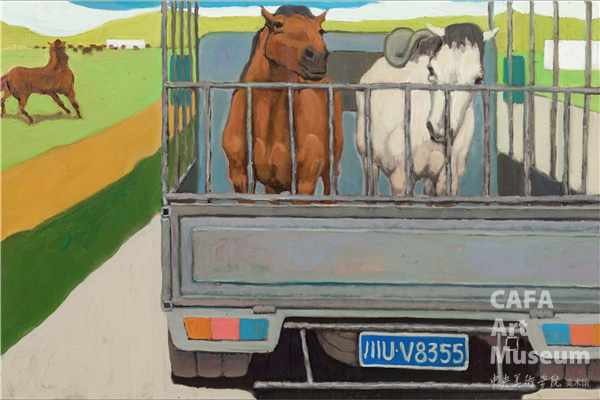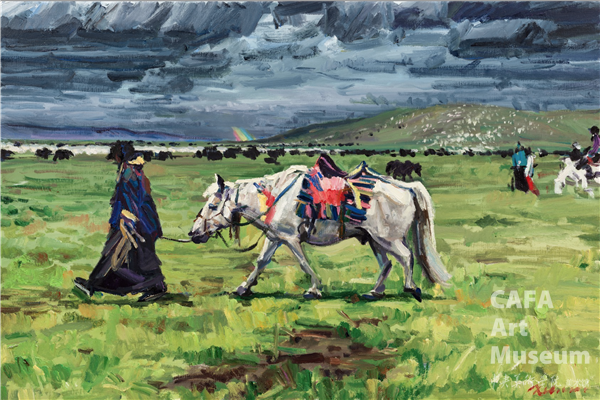
In order to commemorate the 80th anniversary of the victory of the Long March of the Chinese Workers’ and Peasants’ Red Army, and to continue the "Long March Spirit", in September 2016, the Central Academy of Fine Arts organized various departments and majors to revisit the Long March based on their own professional characteristics. According to the different professional characteristics, participants from the various disciplines went deep into life and collected materials at different places along the Long March, completed art works in multiple forms, and had the works exhibited at the National Art Museum of China in October 2016. The Central Academy of Fine Arts, as a century-old education institution, enjoys many theme creations that represent the themes of the Red Army's Long March, including "Prosperous Years" by Lin Gang and Pang Tao, and "Red Army Crossing the Grassland" by Dong Xiwen. These works have become a historical mark that witnesses those prosperous years.

You Qinhuang, Oil on canvas, 60x90cm, 2021.8
In September 2016, Professor Zhang Lujiang, then Deputy Dean of the School of Plastic Arts of the Central Academy of Fine Arts and Director of the Foundation Program, led the team to use "Red Army Recipe" as the creative idea to complete one hundred oil paintings. "Red Army Recipe" is named as "recipe," but it depicts "a hundred inedible foods". The food eaten by the soldiers on the Long March has been transformed into a portrayal of the "Red Army Spirit" during the hard years. The drawing was completed by both teachers and students of CAFA, which formed a new way combining teaching and on-site creation. This was unprecedented in the teaching tradition of the Central Academy of Fine Arts.

Su Hang, Oil on canvas, 60x90cm, 2021.8
Understanding the development of the times and embracing the trend of the times are the tradition and theme of the teaching and creation of the Central Academy of Fine Arts. In 2021, when China has finished building a moderately prosperous society in all respects, and when it comes the centenary of the founding of the Chinese Communist Party, the Central Academy of Fine Arts and CCTV jointly made a 5-episode documentary-“Themed Art Creation in a New Era: Red Army Recipe, Heritage of the Spirit" which consists hundreds of oil paintings, inspired by the creation of then “Recipe Army Recipe” and China’s entering of the New Era. In July 29th 2021, a team led by Professor Zhang Lujiang, Director of the Oil Painting Department, Professor Bai Xiaogang, Director of the Foundation Program at the School of Fine Arts, and Zhang Han and Zhang Di, teachers at the Foundation Program, as well as 15 selected students from various majors, went on the trip to Qiuji Village and Baxi Village of Zoige County and Mao County of Ngawa Tibetan and Qiang Autonomous Prefecture in Sichuan Province to create oil paintings and shoot the documentary.

Qiao Shuyan, Oil on canvas, 60x90cm, 2021.8
“New Era Recipe” interprets the life style of people in the new era from four dimensions:
1) The power of development. From the perspective of Internet of Things, it shows the convenience that the Internet era has brought to the lives of people in China. Inspired by the lifestyle in the era of Internet, of "making good and convenient use of non-local resources", it shows the achievements of the Internet in promoting a better-off life.
2) The power of diligence. It is reflected in the rich material life brought about by mass modernized production. Especially the prosperity of the new era reflected in the food processing and food transportation methods is a portrayal of the people's continuous hard work towards a new life.
3) The beauty of ordinary life. It shows a peaceful well-off life, with ordinary daily narratives reflecting the cornerstone of the vigorous development of the current era.
4) The joy of harvest. It is reflected in the real happiness brought to the people by the harvest.
The above four dimensions guide students to explore creative content from history and life, and guide this new era themed creative class through four creative methods of "re-expectation", "re-interpretation", "re-experience" and "re-expression".

Li Tianyuan, Oil on canvas, 60x90cm, 2021.8
This teaching is characterized by walking into the scene of history and the times, with the goal of cultivating a new generation of young people. The 15 students of the creation team came from oil painting, printmaking, mural painting, sculpture, modeling basics and other majors. From different perspectives such as narration, performance, and reconstruction, they completed the creation by combining artistic forms and themes. This teaching also aims to cultivate students’ understanding towards the society and life by cutting in from small details.

Wan Jingyan, Oil on canvas, 60x90cm, 2021.8
As a recount of teaching in CAFA, the exhibition has three major characteristics:
Combined the students’ personal experience and personality with the contemporary context, also with the basic painting techniques gained in school exercises, and with different art forms, to guide students into the “school of society”. In this process, young students started their re-thinking. For example, Qiao Shuyan said,“Each era has a unique way of artistic expression. The Central Academy of Fine Arts, a school with a century of history, has seen the development of the times in different historical periods. The elder generations understood the issues of the times deeply and formed a historical picture of the century-old development of Chinese art. This new era themed creation class organized by CAFA led me into the real life and to observe the great changes in social life along the path of Long March in the new era. Through this course, I found the methodology that applies to the art creation in the current era.” Shan Yuhan said, “When I create my works, I break away from the feelings of real life from time to time and enter an imaginary creative context. However, this course made me feel that “art comes from the real life'. Art should be honest and sincere, thus can touch the soul of audience. Also this time I spent days and nights with the teachers and classmates, our communication made me grow a lot, which is undoubtedly an unforgettable experience in my university life.”

Xie Jiachen, Oil on canvas, 60x90cm, 2021.8
2. Broke the management boundaries between departments. Formed project creation team with outstanding students from different grades and departments to complete the art works. This reflects the complementarity and advantages of various disciplines and helps students to know more about each department.

Xu Gaoyuan, Oil on canvas, 60x90cm, 2021.8
3. Showed the contemporary responsibility of the Central Academy of Fine Arts. Cultivating artists for people, is the target and responsibility of the CAFA. The "Great Love" is about loving the motherland and the people; the "Great Art" is about telling the story of the Party, the country and the people with art. The highlight of the century-old art education is to cultivate a new generation of artistic talents with independent thoughts, passion, cultural responsibility, and original artistic aspirations. This is also the main theme and fundamental goal of this creative tour.

Ceng Hongji, Oil on canvas, 60x90cm, 2021.8
This exhibition will consist of one hundred "Red Army Recipe" and one hundred "New Era Recipe" art works. This kind of exhibition creates a new context: It not only reflects an idea that all the achievements of the new era are the historical result from the sacrifice of generations of revolutionaries, but also shows a prosperous, harmonious, democratic, and thriving contemporary social spirit.

You Qinhuang, Oil on canvas, 60x90cm, 2021.8


2021-10-22


